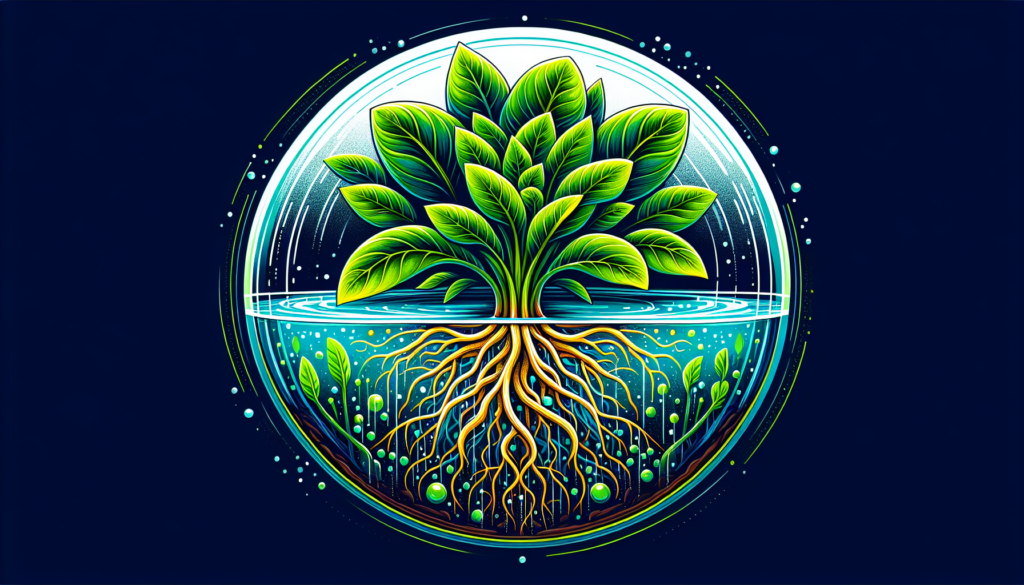Are you interested in discovering a revolutionary way to grow plants without soil? Look no further because hydroponic fertiliser is here to revolutionize the world of agriculture. With this innovative solution, plants can thrive and flourish in a nutrient-rich water-based environment, eliminating the need for traditional soil cultivation. Say goodbye to the limitations and challenges of conventional farming methods and say hello to a more efficient and eco-friendly approach to gardening. Get ready to unlock the secrets of successful hydroponic gardening as we explore the benefits and functions of hydroponic fertiliser.
What is Hydroponic Fertilizer?
Definition
Hydroponic fertilizer is a specialized nutrient solution used in hydroponic gardening to provide plants with the essential nutrients they need for optimal growth. Unlike traditional soil-based gardening, hydroponics relies on a soilless medium, such as water or inert substrates like perlite or gravel, to cultivate plants. Since these mediums do not naturally contain the necessary nutrients, hydroponic fertilizers are used to provide plants with the crucial elements required for healthy development.
Importance
Hydroponic fertilizer plays a critical role in hydroponic gardening as it replaces the nutrients that would typically be found in soil. In hydroponics, plants receive their primary source of nutrients through the fertilizer solution, ensuring they have everything they need to grow and thrive. Properly balanced hydroponic fertilizers supply the essential macro and micronutrients required for robust plant growth, enabling gardeners to achieve impressive yields of high-quality produce.
Benefits
The use of hydroponic fertilizers offers several significant benefits for both home gardeners and commercial growers. Firstly, hydroponics allows for precise control over nutrient levels, ensuring plants receive the ideal balance of nutrients for optimal growth. This control leads to faster growth rates, higher yields, and larger, healthier plants. Secondly, hydroponic fertilizers can be tailored to the specific requirements of different plants, allowing growers to optimize the nutrient solution for each crop. Finally, hydroponic fertilizers minimize the risk of pests and diseases often associated with soil-based gardening, as the soilless medium provides a clean and sterile environment for plants.
Types of Hydroponic Fertilizer
Liquid Fertilizers
Liquid hydroponic fertilizers are the most common form used in hydroponic systems. They are highly soluble and quickly absorbed by plants, providing immediate nutrition. Liquid fertilizers often come in concentrated forms that are diluted with water before application. Their ease of use and fast-acting nature make liquid fertilizers a popular choice among hydroponic gardeners.
Powdered Fertilizers
Powdered hydroponic fertilizers are another widely used option in hydroponics. They come in a powdered or granular form and need to be dissolved in water before application. Powdered fertilizers are often cost-effective and have a longer shelf life compared to liquid fertilizers. However, they may require more precise measuring and mixing to ensure the nutrients are properly distributed.
Organic Fertilizers
Organic hydroponic fertilizers are derived from natural sources, such as plant and animal materials. These fertilizers are often rich in slow-release nutrients and beneficial microorganisms, contributing to long-term soil health. Organic hydroponic fertilizers are popular among organic growers who prioritize sustainable and environmentally friendly practices.
Synthetic Fertilizers
Synthetic hydroponic fertilizers are chemically formulated and contain specific ratios of macronutrients and micronutrients. They are typically highly concentrated and provide plants with readily available nutrition. Synthetic fertilizers are preferred when precise control over nutrient levels is required, allowing growers to fine-tune the nutrient solution for different plant varieties and growth stages.
Mineral-Based Fertilizers
Mineral-based hydroponic fertilizers are formulated using mineral salts dissolved in water. These salts are carefully selected to provide plants with the necessary nutrients in a readily available form. Mineral-based fertilizers are known for their efficiency in hydroponic systems, as they can maximize nutrient uptake and minimize waste.

Components of Hydroponic Fertilizer
Macronutrients
Macronutrients are the essential elements required by plants in large quantities for vital physiological processes. These include nitrogen (N), phosphorus (P), and potassium (K), commonly known as NPK. Nitrogen aids in leaf and stem growth, phosphorus promotes root development and flowering, and potassium supports overall plant health, disease resistance, and fruit production.
Micronutrients
Micronutrients, also known as trace elements, are essential elements needed by plants in smaller quantities. These include iron (Fe), manganese (Mn), copper (Cu), zinc (Zn), boron (B), molybdenum (Mo), and chlorine (Cl), among others. Although required in smaller amounts, micronutrients are crucial for various plant metabolic functions and play a vital role in overall plant health.
Secondary Nutrients
Secondary nutrients are essential elements needed by plants in moderate amounts. These include calcium (Ca), magnesium (Mg), and sulfur (S). Calcium supports cell wall structure and prevents diseases, while magnesium is a crucial component of chlorophyll and aids in photosynthesis. Sulfur is involved in numerous enzymatic reactions and protein synthesis.
Growth Stimulants
Growth stimulants are substances that enhance plant growth and development. These can include hormones like auxins, cytokinins, gibberellins, and brassinosteroids, as well as natural or synthetic compounds that promote root growth, flowering, or fruit set. Growth stimulants are often included in hydroponic fertilizers to maximize plant productivity.
pH Regulators
pH regulators are used to adjust and maintain the pH level of the hydroponic nutrient solution. Different plants have specific pH requirements for optimal nutrient uptake and growth. pH regulators, such as acids or bases, are added to the nutrient solution to maintain the desired pH range and prevent nutrient deficiencies or toxicities.
Choosing the Right Hydroponic Fertilizer
Plant Requirements
When selecting a hydroponic fertilizer, it is crucial to consider the specific nutrient requirements of the plants being grown. Different plant varieties have varying needs for macronutrients, micronutrients, and other essential elements. Understanding these requirements will help ensure that the chosen fertilizer provides the necessary nutrients for healthy plant growth.
Water Quality
The quality of the water used in hydroponics can have a significant impact on nutrient availability to plants. It is essential to test the water for pH, mineral content, and potential contaminants. Some fertilizers are specifically formulated for use with certain water types, while others may require additional water treatment or adjustments to achieve optimal nutrient absorption.
NPK Ratio
The NPK ratio refers to the relative amounts of nitrogen (N), phosphorus (P), and potassium (K) in a hydroponic fertilizer. Different plant species and growth stages require varying NPK ratios to meet their nutritional needs. Understanding the desired NPK ratio for the intended crop will aid in selecting the right hydroponic fertilizer.
pH Compatibility
Each plant has an ideal pH range in which it can efficiently absorb nutrients. It is crucial to choose a hydroponic fertilizer that is compatible with the desired pH range of the plants being grown. pH adjustments may be necessary when using certain fertilizers to ensure optimal nutrient availability.
Environmental Considerations
When choosing a hydroponic fertilizer, it is essential to consider the environmental impact of the product. Some fertilizers may contain ingredients that can harm the environment or lack sustainability. Opting for organic or environmentally friendly fertilizers can help minimize the ecological footprint of hydroponic gardening.

Application Methods
Drip Irrigation
Drip irrigation is a commonly used method in hydroponics where a nutrient solution is continuously dripped onto the growing medium or root zone of plants. This method ensures a slow and consistent delivery of nutrients to the plants, promoting efficient nutrient uptake and minimizing waste.
Foliar Spraying
Foliar spraying involves applying a diluted hydroponic fertilizer solution directly to the plant leaves. This method allows for rapid absorption of nutrients through the leaf surface, bypassing the root system. Foliar spraying is often used for quick correction of nutrient deficiencies or as a supplement to root feeding.
Nutrient Film Technique (NFT)
Nutrient Film Technique (NFT) involves suspending plant roots in a shallow, nutrient-rich film of water flowing through inclined channels or gutters. The nutrient solution is continuously recirculated, ensuring a constant supply of nutrients to the roots while maintaining an oxygen-rich environment.
Ebb and Flow
Ebb and flow, also known as flood and drain, is a hydroponic system that periodically floods the growing medium with a nutrient solution and then allows it to drain back into a reservoir. This cycle ensures regular nutrient delivery to the roots while preventing waterlogging and maintaining oxygen levels.
Aeroponics
Aeroponics is a high-tech hydroponic system that suspends plant roots in a mist or fog of nutrient-rich solution. This method provides excellent oxygenation to the roots, enabling rapid nutrient uptake and promoting optimal plant growth. Aeroponics is known for its ability to achieve high yields in a limited space.
Managing Nutrient Levels
Monitoring
Monitoring nutrient levels in a hydroponic system is crucial for ensuring plants receive the right amount of nutrients at all times. Regular testing of the nutrient solution through electrical conductivity (EC) and pH meters provides insights into nutrient concentration and pH levels. Monitoring the nutrient solution’s temperature is also important to prevent imbalances or nutrient deficiencies.
Adjusting
Adjusting nutrient levels involves making appropriate modifications to the hydroponic fertilizer solution based on the monitoring results. This may include increasing or decreasing the fertilizer concentration, changing the NPK ratio, or adjusting pH levels. Regularly adjusting nutrient levels ensures plants receive optimal nutrition throughout their growth cycle.
Preventing Nutrient Imbalances
To prevent nutrient imbalances, it is crucial to maintain the correct NPK ratio and monitor secondary and micronutrient levels. A balanced fertilizer and regular monitoring can help prevent deficiencies or toxicities that can negatively affect plant growth and productivity.
Flushing the System
Flushing the hydroponic system involves periodically draining and replacing the nutrient solution with fresh water. This process helps remove any accumulated salts or excess nutrients that may lead to nutrient imbalances or salt buildup. Flushing the system ensures a clean and well-balanced nutrient solution.

Common Hydroponic Fertilizer Problems
Nutrient Lockout
Nutrient lockout occurs when a plant’s root system is unable to access or absorb certain nutrients due to imbalanced pH levels or interactions between different nutrients. This can result in nutrient deficiencies even when the nutrients are present in the solution. Proper pH adjustment and regular monitoring can help prevent nutrient lockout in hydroponic systems.
Nutrient Burn
Nutrient burn, also known as fertilizer burn, occurs when plants are exposed to excessive amounts of nutrients. This typically happens when the fertilizer concentration is too high and exceeds the plants’ ability to absorb and utilize the nutrients. Diluting the nutrient solution and adjusting the fertilizer concentration can help prevent nutrient burn.
Algal Bloom
Algal bloom is the rapid growth of algae in the nutrient solution, often due to excessive lighting or the presence of organic matter. Algae can deplete oxygen levels, inhibit nutrient uptake by plants, and create a conducive environment for diseases. Proper light management and regular cleaning can help prevent algal bloom in hydroponic systems.
pH Fluctuations
pH fluctuations in the nutrient solution can disrupt nutrient availability and absorption by plants. Fluctuations can be caused by factors such as improper pH adjustment, low-quality water, or imbalanced nutrient levels. Monitoring and adjusting pH regularly can help maintain stable pH levels, ensuring optimal nutrient uptake.
Plant Deficiencies
Despite careful nutrient management, plants in hydroponic systems can still develop nutrient deficiencies. Common deficiencies include yellowing leaves (indicating nitrogen deficiency), stunted growth (indicating phosphorus deficiency), and poor fruit development (indicating potassium deficiency). Regular monitoring and adjusting nutrient levels can help prevent and address these deficiencies.
Hydroponic Fertilizer Storage and Precautions
Proper Storage
Hydroponic fertilizers should be stored in a cool, dry place away from direct sunlight. Extreme temperatures, moisture, and sunlight can degrade the fertilizer or alter its nutrient content. Fertilizer containers should be tightly sealed to prevent moisture absorption and contamination.
Handling Safety
When handling hydroponic fertilizers, it is essential to follow the manufacturer’s instructions and wear appropriate protective equipment, such as gloves and goggles. Some fertilizers may be corrosive or irritants, posing risks to the skin, eyes, or respiratory system. Handling precautions ensure personal safety and prevent accidental exposure.
Preventing Contamination
To prevent contamination of the hydroponic nutrient solution, it is crucial to maintain proper hygiene practices. This includes using clean tools and containers, avoiding cross-contamination between different nutrient solutions, and minimizing contact between the nutrient solution and external contaminants.
Disposal Guidelines
Hydroponic fertilizers should be disposed of properly according to local regulations. Some fertilizers may contain toxic or harmful substances that can harm the environment if not disposed of correctly. Following recommended disposal guidelines ensures the safe and environmentally responsible management of hydroponic fertilizers.
Hydroponic Fertilizer vs. Soil Fertilizer
Advantages of Hydroponic Fertilizer
Hydroponic fertilizer offers several advantages over soil-based fertilizers. Firstly, hydroponics allows for precise control over nutrient levels, ensuring plants receive the ideal balance of nutrients for optimal growth. This control results in faster growth rates, higher yields, and healthy plants. Secondly, hydroponic fertilizers can be tailored to the specific requirements of different plants, enabling growers to optimize nutrient solutions for each crop. Finally, hydroponics minimizes the risk of pests and diseases often associated with soil-based gardening, as the soilless medium provides a clean and sterile environment for plants.
Advantages of Soil Fertilizer
While hydroponic fertilizers offer numerous benefits, soil-based fertilizers also have some advantages. Soil provides a natural buffer for nutrients, allowing plants to access nutrients over an extended period. Soil fertilizers can also enhance soil structure, moisture retention, and microbial activity, promoting long-term soil health. Additionally, soil-based gardening may be more accessible and familiar to some gardeners, requiring less specialized equipment and knowledge.
Comparative Analysis
The choice between hydroponic and soil fertilizers ultimately depends on individual preferences, specific growing conditions, and crop requirements. Hydroponic fertilizers excel in precise nutrient control and efficient plant growth, making them ideal for maximizing yields in controlled environments. Soil fertilizers, on the other hand, focus on enhancing soil health and may be preferred for sustainable, natural gardening methods. Understanding the advantages and limitations of each type of fertilizer allows gardeners to make informed choices based on their specific goals and resources.
Future Developments in Hydroponic Fertilizer
Nutrient Delivery Systems
Advancements in hydroponic technology are continually improving nutrient delivery systems. These innovations aim to optimize nutrient absorption and reduce waste by developing more efficient irrigation methods, nutrient dosing systems, and delivery mechanisms. Future nutrient delivery systems may incorporate automation, sensor technologies, and precision nutrient control to further enhance plant growth and productivity.
Smart Fertilizer Monitoring
The use of smart technologies in hydroponic fertilizer monitoring is gaining traction. Smart systems can monitor nutrient levels, pH, temperature, and other crucial parameters in real-time, sending alerts or making automatic adjustments when necessary. This technology allows growers to remotely manage their hydroponic systems more effectively, improving overall plant health and reducing the risk of nutrient imbalances.
Organic Hydroponics
The development of organic hydroponic fertilizers is an exciting area of research. Organic hydroponics aims to combine the benefits of hydroponics with organic farming practices, focusing on sustainability and minimizing environmental impact. Researchers are exploring innovative approaches, such as utilizing organic amendments, beneficial microorganisms, and natural nutrient sources, to develop organic-certified hydroponic fertilizers.
Sustainable Formulations
As environmental concerns continue to grow, the development of sustainable hydroponic fertilizer formulations is becoming increasingly important. This includes using renewable resources, minimizing waste generation, and reducing the ecological footprint of hydroponic systems. Sustainable hydroponic fertilizers aim to provide efficient nutrient solutions while prioritizing responsible environmental practices.
In conclusion, hydroponic fertilizer plays a vital role in hydroponic gardening by providing plants with the essential nutrients they need to grow and thrive. It offers several benefits, including precise nutrient control, higher yields, and reduced risk of pests and diseases. Various types of hydroponic fertilizers, such as liquid, powdered, organic, synthetic, and mineral-based, are available to suit different gardening preferences. Understanding the components of hydroponic fertilizer, such as macronutrients, micronutrients, and growth stimulants, allows growers to tailor nutrient solutions to specific plant requirements. Proper selection and application of hydroponic fertilizers, coupled with regular monitoring and management, help prevent common problems such as nutrient imbalances or deficiencies. Hydroponic fertilizers also differ from traditional soil fertilizers, with each having its advantages and limitations. Additionally, ongoing developments in hydroponic fertilizer are focused on nutrient delivery systems, smart monitoring technologies, organic hydroponics, and sustainable formulations. With these advancements, the future of hydroponic fertilizers holds promising opportunities for improved plant nutrition and sustainable agricultural practices.





